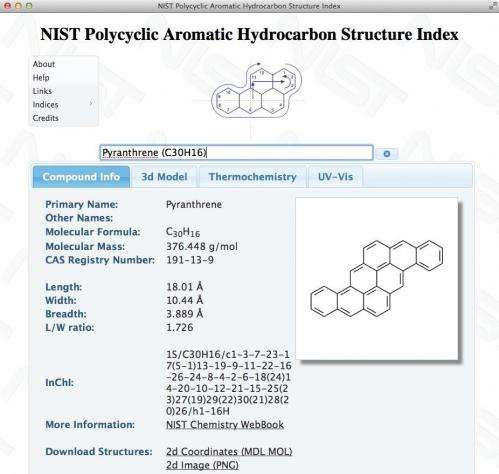NIST creates polycyclic aromatic hydrocarbon structure index

Recently, a new website containing a wealth of information on polycyclic aromatic hydrocarbons (PAHs) was made publicly available by NIST. PAHs are compounds that are produced during the combustion of hydrocarbon fuels and have significant adverse health and environmental effects. The website contains data on more than 650 PAH compounds, with many more to be added in the near future.
The site was created as part of the commitment of the Chemical Informatics Research Group of NIST's Material Measurement Laboratory to provide Standard Reference Data to industry, academia, and the U.S. public, and builds on NIST Special Publication 922: Polycyclic Aromatic Hydrocarbon Structure Index (SP922) by Dr. Lane C. Sander and Dr. Stephen A. Wise of NIST. The purpose of SP922 was to index a large number of PAH structures and to provide parameters for estimating retention indices for liquid chromatography using a simple model. The new website incorporates all of the material from SP922 as well as much new information. For example, three-dimensional structures of the PAH molecules optimized using a popular density functional theory (DFT) computational method are displayed and the coordinates are available for download for further use as two-dimensional structural representations. Additionally, the new website incorporates a number of useful features including a powerful search engine that displays partial-name matches as the user types their query. Wherever possible, the PAH website links to the NIST Chemistry WebBook, one of the most popular websites at NIST, to provide users with additional chemical information.
Data from two new research efforts have been made available on the website as well. The first is a collection of thermochemical data on gas-phase PAH compounds. These data are derived from DFT calculations and have been validated against experimental data whenever possible. A full description of the methods used to produce this data is available in a forthcoming journal article by Drs. Thomas C. Allison and Donald R. Burgess Jr. entitled "First Principles Prediction of Enthalpies of Formation for Polycyclic Aromatic Hydrocarbons and Derivatives." Thermochemical data is presented in the JANAF table format that will be familiar to many users. The second effort has made UV/Visible spectra computed using time-dependent DFT available to users.
Suggestions for new compounds and data types from the PAH community are encouraged. With the publication of this database, NIST is extending its long-standing interest in PAH chemistry and renewing its commitment to providing significant, high-quality data to the community of PAH researchers.
Provided by National Institute of Standards and Technology


















